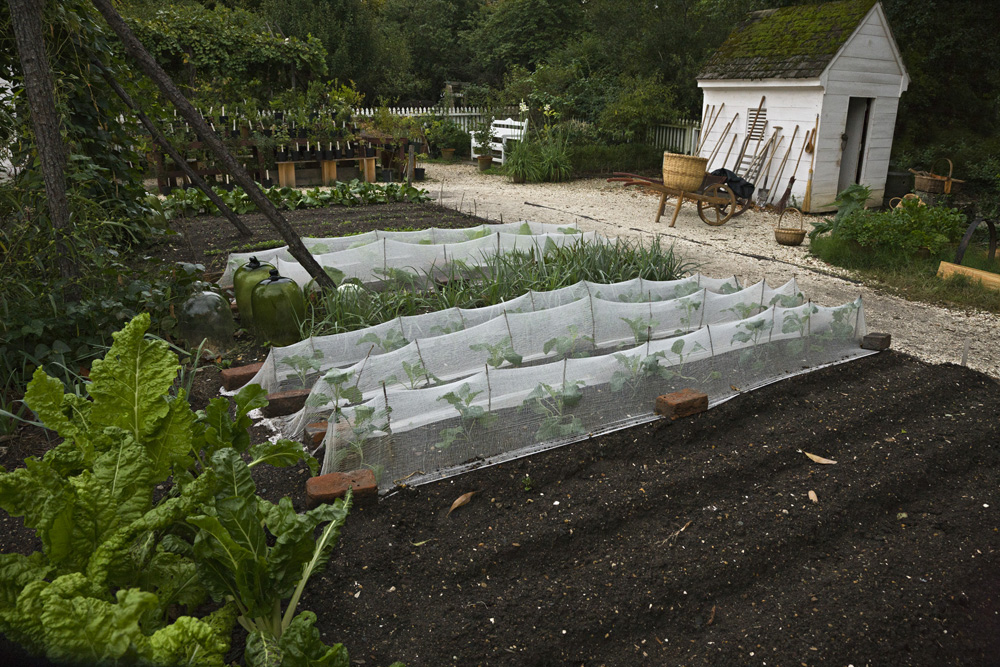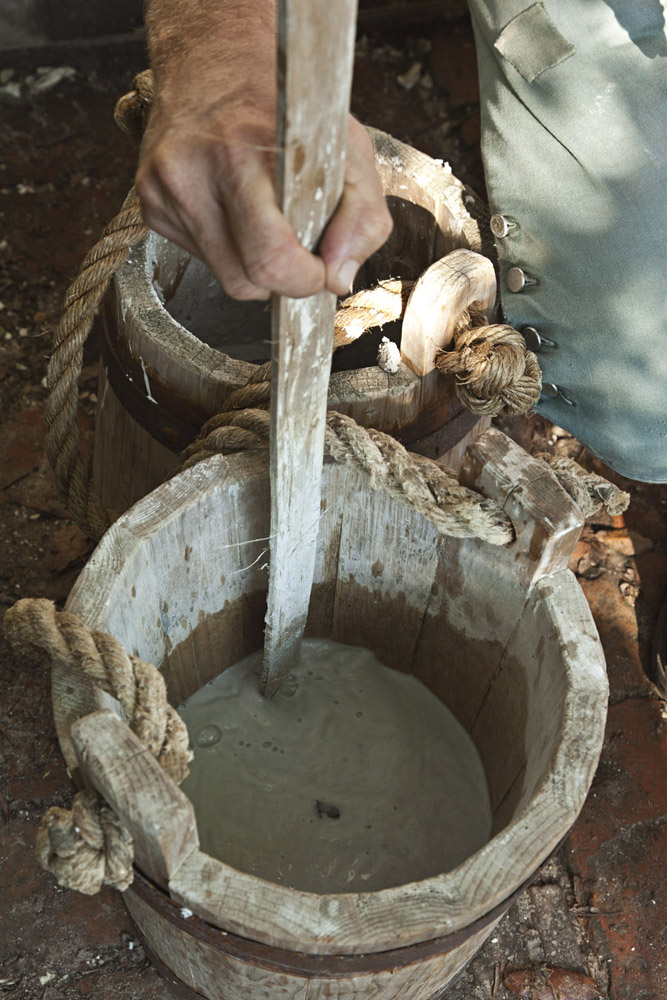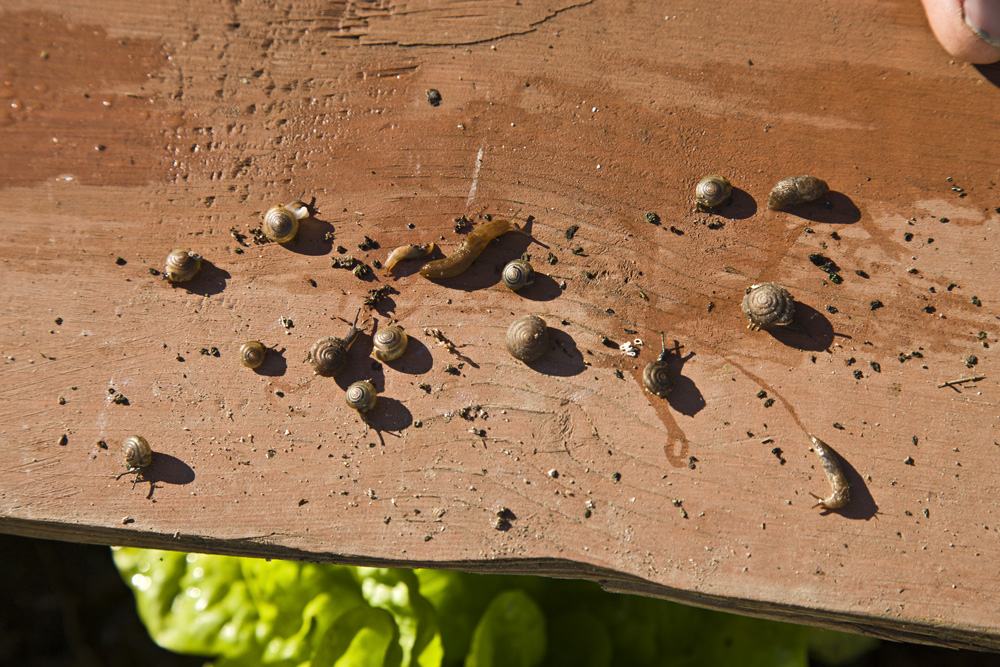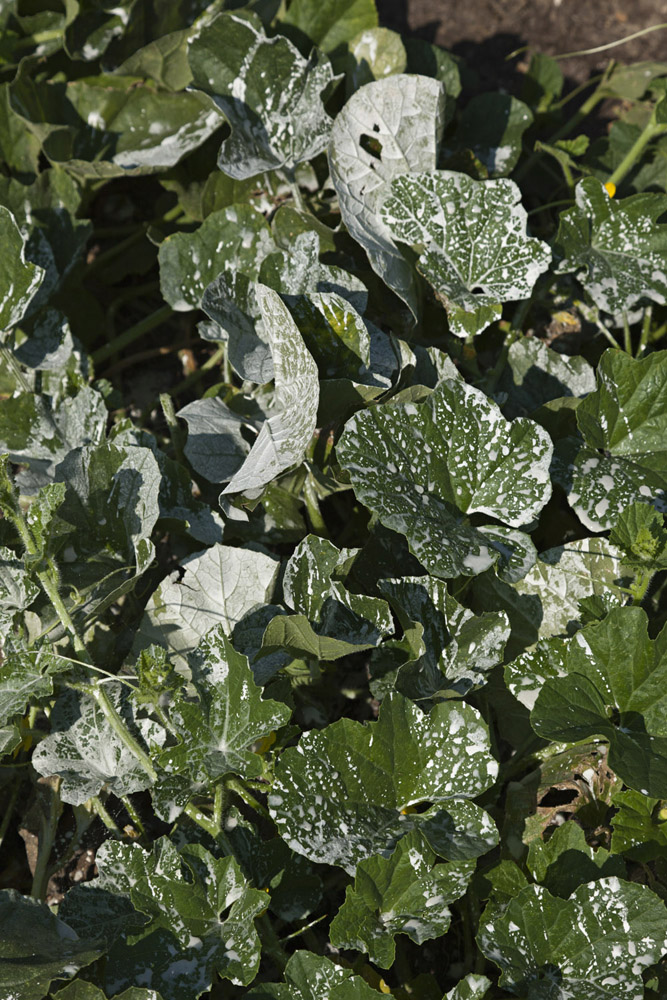
Ox Urine to Olive Oil: Fighting Garden Pests Like the Colonists

Wesley Greene is garden historian for the Colonial Williamsburg Foundation. This article is adapted from one that originally appeared as "Snails, Flies and Caterpillars" in The Interpreter. Greene contributed this article to Live Science's Expert Voices: Op-Ed & Insights.
When humans first gathered food plants into a garden, they simultaneously created an ideal habitat for insects to feed, initiating a battle for sustenance that continues to this day. For the largest part of human history, the insects have had the upper hand.
In the Colonial Garden at Colonial Williamsburg, we face the same challenge, but use centuries-old techniques to fight back.
The first English garden book, "The Gardeners Labyrinth" (1577) written by Thomas Hill, records:
"There is none so dul of eye-sight (as I believe) who not thorowly perceiveth and seeth, how that the Garden riches be diversly annoyed, and harmed by divers creeping worms and beasts, as wel above as under the earth, and that through the same occasion, often procured to feeble and wast, and unlesse speedy remedies shall be exercised, that these in the end do fall down and perish." [Editor's note: original text spellings are used throughout this article.]
The remedy, of course, has been the problem. In his book, Hill recommends many of the same techniques that had been practiced for more than a thousand years at the time and that continued well into the 19th century. Plants were sprinkled with fig tree ashes, ox urine, olive oil and the soot of chimneys. Sulfur, lixivium of limewater (a solution of slaked lime) and assafætida (an evil-smelling latex from the roots of several species of Ferula plants) were sprayed on the leaves. Bundles of garlic, brimstone (sulfur), goat hooves and hart's horn were burned between the rows to ward off pests.
Pests born from the morning dew
Get the world’s most fascinating discoveries delivered straight to your inbox.
For people of the time, the very origin of the insects that attacked the plants was a mystery. For more than a thousand years, gardeners believed insect and disease organisms arose through spontaneous generation. According to Aristotle, plant lice (aphids) arose from the morning dew and field mice were created by dirty hay.
One of the first scientific investigations into spontaneous generation was conducted by the Italian physician, Francesco Redi, in 1668. It was generally believed that maggots arose spontaneously in rotting meat, but Redi postulated that the organisms actually arose from the eggs laid by flies. To test his hypothesis, Redi set meat out in a number of flasks, some open to the air, some sealed completely and others covered with gauze. The maggots appeared only in the open flasks, proving that the flies had to be able to reach the meat to lay their eggs.
The debate over spontaneous generation continued through the 18th century. In 1745, the English clergyman John Needham conducted what he claimed to be the experiment that definitively settled the debate. After the invention of the microscope, it was readily apparent that boiling killed microorganisms. So, in his experiment, Needham boiled chicken broth in a flask and then allowed the liquid to cool. Within a few days, microorganisms had formed a scum on the surface of the broth, proving the theory of spontaneous generation, Needham claimed.
Lazzaro Spallanzani, an Italian priest, was not convinced. In 1768, he proposed that the microorganisms had been introduced from the air. In his experiment, he boiled meat broth in one flask that was allowed to stand open and in another that was sealed. The open flask grew microorganisms; the sealed flask did not. Doubters argued that this only proved that spontaneous generation could not occur without air.
In 1859, the French Academy of Sciences solicited experiments to prove or disprove spontaneous generation. A young French chemist named Louis Pasteur created the experiment that finally lay to rest the theory of spontaneous generation (decades before he developed the rabies vaccine). In his experiment, as others had in the earlier tests, Pasteur boiled meat broth in a flask. But he modified the container by heating the neck of the flask and bending it into an S shape so that air could enter but airborne spores could not. The broth in the flask remained clear. In a definitive demonstration, he then tipped the broth into the lowest part of the neck, where spores had settled through gravity, and the broth rapidly clouded over. This not only disproved spontaneous generation, but also demonstrated the ubiquity of microorganisms in the air.
From whence the insects came
The confusion over the origins of insects is apparent in many 18th-century garden works. Leonard Meager, a gardener in Northamptonshire, records in "The Compleat English Gardner" (1704):
"Caterpillars, of which there are several sorts, but those are the worst enemies to Trees and Fruit which are bred by the East Wind. To counter this evil: some affirm with much confidence, that the oft smoaking of them with old Hay, or Straw, using the advantage of the Wind in the Spring, to be a sure prevention."
Philip Miller, superintendent of the Chelsea Physic Garden, writes in "The Gardeners Dictionary" (1768):
"Some have supposed that blights are usually produced by an easterly wind, which brings vast quantities of insects' eggs along with it from some distant place; which, being lodged upon the surface of the leaves and flowers of fruit-trees, cause them to shrivel up and perish."
Today, as then, caterpillars are particularly bothersome, one of several insect pests that afflict the cabbage family. The green caterpillar of the imported cabbage worm is familiar to anyone who has ever grown broccoli, cauliflower, collards or cabbage. Richard Bradley, a member of the Royal Society and first botany professor at Cambridge University, writing in "The Gentleman and Gardener's Kalendar" (1720), also recognized the vast potential these insects have to reproduce, saying:
" . . . every Insect increases Yearly about 400, and some of them many more; for Example, those Caterpillars which feed upon the Cabbage, and change into the common White Butter flies, breed twice every Year, each of them laying near 400 Eggs at one time; so that from the second Brood of one single Caterpillar, we may reasonably expect 160,000."
In "The Farmer's Instructor or the Husband and Gardener's Useful and Necessary Companion" (1747), a work begun by gentleman Samuel Trowell and enlarged and finished by farmer William Ellis, the authors were great believers in the virtues of manure in controlling insect pests. In regard to the cabbage worm, they record:
" . . . when the Plant is grown large, the white-wing'd Butterfly lays his Eggs, which brings a Caterpillar at the Bottom of the Leaf, and when they come to be large, devours the whole Plant … Now to prevent this Mischief, take some of the Lixivium made of the Manure, and water the plants with it, which will destroy all the Caterpillars, be thy ever so many, nor will they come there any more."
William Thompson, gardner to the Duke of Ancaster, in "The New Gardener's Calendar" (1779) suggests salt:
"When your cabbages and coleworts are infested with caterpillars, take some salt water, and sprinkle it over them; this method has been frequently found to be effectual."
When is a fly a fly?
The origin of the white butterfly that produced the green caterpillar remained a mystery throughout the 18th century. John Hill, an apothecary, botanist and occasional actor, writes in "Eden, or a Compleat Body of Gardening" (1773) with this advice for the gardner in the month of November:
"On the Tops of the Branches in his Hedges, and on many Trees that are about the place, he will see Bags like Cobwebs: these are the Nest of the Caterpillars that will the next Year eat his Cabbages and other valuable Products; let him cut them off, and burn them."
The webworm that Hill writes of is not the source of cabbage worms. He further observes:
"Chuse for this Purpose [planting cabbage], an open Piece of Ground, far from Trees or Hedges, for Caterpillars breed among the Leaves of these; and the Butterflies, that produce those Devourers, frequent such Places more than open Ground."
Many authors recommend placing cabbages at a distance from trees or hedges, and while that would have no effect in controlling the cabbage caterpillar, this may actually be good advice for combatting another pest of cabbage: the cabbage flea beetle. The flea beetle shelters in vegetation on the edges of gardens or fields, so placing your plants away from hedges may have some benefit. The cabbage flea beetle is a pest on canola crops in the northern United States today, and research from Washington State University has shown that flea beetle damage on canola seldom occurs farther than 50 yards (46 meters) from the edge of a field.
The confusion for modern readers of 18th-century garden works — as well as 18th-century authors who read, and often plagiarized each other — is that just about any insect that hops, flutters or flies is called a "fly." This can make identification confusing for the reader, and for this reason, information about one "fly" is often attributed to a different insect in those books.
In "The Practical Kitchen Gardiner" (1727), Stephen Switzer — a garden designer and one of the first proponents of a move away from the classic formal gardens of the 17th century — is speaking of the flea beetle when he writes concerning coleworts (similar to the modern collard greens) that it:
"is often apt to be eat up in the seedleaf as other cabbage seeds are with the black fly. It is only in the seedling stage that cabbages are damaged by the flea beetle."
To prevent damage from the beetle, he suggests, "as soon as the seed is sown and rak'd in, you should sow some slack'd lime, the virtue of which will last till some rain succeeds, after which the seed will soon sprout, and be out of danger."
The use of lime very likely does provide some protection from the flea beetle, as lime is extremely caustic.
Philip Miller recommends using radishes as a trap crop with cauliflower. Trap crops are more attractive (to an insect) and lure them away from the crop a gardener wishes to protect.
"If there are not some Radishes amongst them, and the month of May should prove hot and dry, as it sometimes happens, the fly will seize your Cauliflowers, and eat their leaves full of holes, to their prejudice, and sometimes their destruction; whereas, if there are Radishes upon the spot, the flies will take to them, and never meddle with the Cauliflowers."
This would likely have some limited effect, as the flea beetle seems to prefer radish over cauliflower.
This same insect and a number of its relatives also feed on turnips. Switzer writes:
"There is a black fly that always fastens upon them, and eats the seed-leaves in their first coming up in the summer-time, which spoils that crop entirely, if not prevented." To prevent the fly he recommends: "some have sap or seminated soot out of the chimney, wood-ashes, and the like strewn over the young plants."
Organic gardeners in England will often spread ashes amongst turnips to this day to ward off this troublesome fly.
In "Modern Eden" (1767), gardeners John Rutter and Daniel Carter suggest a more elaborate method to combat the turnip fly:
"Steep the seed in the following liquor: Boil a good quantity of tobacco stalks in water till it is very strong of them; then stir into this some aloes, soot and flour of brimstone. Put in the seeds, and let them lie 18 hours; then draw off the liquor and sow them with the ingredients."
Trowel, ever the proponent of manure, writes:
"Manure must be of very great Service here, because it will prevent the Fly's Mischief, that is the chiefest Insect that spoils Turnips; for altho' the Rains may wash it, yet its Efficacy will hold strong enough to prevent its Hurt."
Another vexing problem was the fly on the broad or horse bean (known to most Americans as the fava bean). Trowel writes in 1747:
"Many Farmers' and Gardeners' Bean-Crops in the Spring-season of 1746, where the Seed was sown or set too early … their Horse-beans in particular suffered much by the destructive Dolphin Fly, bred by the frequent Showers of Rain, and the hot Glades or the Sunbeams that interposed their scorching Rays between their falling, and produced this horrid Insect, which no Manure, sowed over the Ground, can prevent: but I will here make known a Way to prevent this Collyer Fly's Damage … These black Dolphin Flies always begin their Settlement on the top part of the Bean-stalk, and there carry on their Increase till they get down almost to its bottom, and live on the Sap of it, by which they poison and destroy it … I am the first Author that discovered this Remedy, and this is, when a Crop of Horse-beans is perceived to be seized by this Dolphin Fly: Then let a Man make use of a Scythe, and go in among them, and mow their Tops off so far as the Fly has settled … when all the Tops are cut off, the Fly falls with them on the Ground, and can never rise again."
In Trowel's case, the insect is actually an aphid, but English gardeners still top beans to combat what is now known as the black bean aphid. The aphids are often found on the newest growth, so this method would reduce the population and also hasten the ripening of the beans lower on the stem.
Stopping slugs and snails
All of the above insects are fairly host specific. Slugs and snails, on the other hand, are indiscriminate feeders. In "A Compleat System of Husbandry and Gardening" (1716), John Worlidge, a British gentleman and agriculturalist, writes:
" . . . there cannot be a more pernicious Enemy than Snails, which you may in a Dewy Morning easily find where they most delight to feed; but the surest way is in the hard Winter to seek our their haunts, and make a clean riddance of them: They lie much in the holes of Walls, behind old Trees, under Thorn, and other old and close Hedges. In one Year, I caused near two Bushels to be gathered in a Nobleman's Garden, which had in precedent Years destroyed the most of their Wall-Fruit, and ever after they had great plenty of Fruit."
The most common method of gathering snails is explained by Tompson in 1779:
"If you place bricks, tiles or boards hollow against your pales and walls, the snails will creep under them for shelter, and may then be taken."
This is a simple trap that can be effectively used today. Simply lay boards amongst your plants, and remove the snails and slugs that collect under them each morning.
The final solution is provided by John James, translating an original French work by J. Dezallier d'Argenville, in "The Theory and Practice of Gardening" (1712):
"They are easily taken with your Hand, if you look for them Morning and Evening, especially after Rain, for then they come out in the greatest Abundance; they should be presently crush'd under Foot."
Aphids give ants a bad name
The aphid, or plant louse, is nearly ubiquitous in gardens worldwide. The insect's success is due to its extraordinary reproductive proficiency. All aphids are parthenogenic, meaning the females do not require males to produce offspring, and in some genera of aphids, males have never been found.
In "A New System of Natural History" (1792), British scientists Peter Hill and Thomas Cadell describe the damage aphids inflict:
"They are furnished with a small trunk, which pierces the leaves, and enables the animal to extract the juices proper for its nourishment. Many plants grow deformed by the number of punctures thus made upon their leaves."
(Hill and Cadell are also known for theorizing that America and Americans were inferior due to the lack of large mammals on the continent, a theory Thomas Jefferson tasked Lewis and Clark with dispelling.)
Worlidge writes,
"By reason of great Drought, many sorts of Trees and Plants are subject to Lice: And seeing that they are caused by Heat and Drought, as is evident in the Sweetbryar and Gooseberry, that are only Lowsy in dry times, or in very hot and dry places; therefore frequent washing them, by dashing Water on them, may prove the best remedy."
Drought, of course, does not produce aphids, but the damage from aphid feeding is much more pronounced in drought conditions, which likely explains the phenomena that Worlidge observes. It is probably aphids that gave the ant a bad name among 18th-century gardeners. Ants are attracted to the honeydew emitted by aphids, and like an army of farmers, "milk" the aphids for the honeydew and protect their "herd" from predators. Ants do not damage plants themselves other than in aiding the aphids, but most 18th-century gardening works give ideas for killing these relatively harmless insects.
In "Kalendarium Universale," (1748) the father and son gardeners Benjamin Whitmill the elder and Benjamin Whitmill the younger suggest the following:
"Some Persons recommend the cutting of Dew-Worms in small Pieces, and strewing them for Ants in proper Places which they do frequent; to these, they will resort in great Numbers for Food, and may be easily destroy'd by the Help of a Watering-Pot of scalding Water."
Pests destroying pests
Hill and Cadell give a novel use of ants in an early example of natural pest control:
"In Switzerland, however, they are transported to trees for a different purpose: the destruction of caterpillars and other vermin. A bag filled with ants is fastened to a tree, with a small hole purposely left open for them to creep out; they spread along the tree, and are prevented from leaving it, by a quantity of pitch with which the stem is covered. Rather than die by famine, they go in pursuit of the caterpillars among the leaves and devour them."
The authors also recognize the role of beneficial insects in controlling plant pests. Concerning aphids, Hill and Cadell observe:
"The most effectual method of preventing the depredations of plant lice upon flowers and leaves to plants is suggested by those insects which live by preying upon them [the lice]. The plant louse-lion, or aphidivorous fly, either by instinct or foresight, deposits her eggs in the midst of these animals; and as soon as the larvæ are produced, they devour hundreds around them."
The authors are likely referring to ladybugs.
Parasitic wasps are important predators of many insect pests. Hill and Cadell are also familiar with the most important family of these wasps.
"Ichneumon — one striking peculiarity in the manners of some insects of this genus, who make their way into the body of the caterpillars of different kinds, and there deposite their eggs [is that]… The ova hatched within the caterpillar after being quickened into life, preys upon the intestines of that animal."
A control method for both insect and disease problems that is widely practiced to this day is a system of crop rotation. Meager writes in 1704:
"Another thing I would have you take notice of, and that is that you do not sow one sort of Crop too often upon one and the same piece of ground, but sow it with changeable Crops, especially Parsnips and Carrots, the which being sown too often without change, will be apt to canker, rot or be very apt to be Worm-eaten, although the ground be maintained very rich."
Gardeners recognize the importance of crop rotation today as an effective method of pest control.
[Everyday Citizens Can Help Solve the Riddle of the Disappearing Ladybugs]
Pest control, the Colonial Williamsburg way
How did the colonists in Virginia deal with insect pests in the vegetable garden? For the most part, they did not have to, because the majority of insects that plagued their crops in England had not yet arrived in America!
The imported cabbage worm was introduced first to Quebec and did not find its way to Massachusetts until around 1869. The flea beetles that infested the English cabbage and turnips did not arrive in America until the 20th century. The species of slugs and snails plaguing Britain arrived in America sometime in the 19th century, and to this day, I have never seen a black bean aphid on my broad beans. New World pests such as the Colorado potato beetle and the Mexican bean beetle never made it within a thousand miles of Virginia in the 18th century.
There were a few garden pests waiting for the colonists in North America, such as the cabbage looper and striped cabbage caterpillar that gardeners occasionally see today. The striped cucumber beetle is native to North America as is the squash vine borer. John Randolph, last Royal Attorney General of the colony of Virginia (a loyalist who returned to England in 1775), writing in "A Treatise on Gardening" (1793) from Williamsburg in the 18th century, gives this warning concerning raspberries: "They are pestered with lice, but limewater kills them, if sprinkled upon them." However, very few insect problems are recorded by our colonial predecessors in the vegetable garden.
Robert Beverley Jr., a gentleman, historian and politician in colonial Virginia observed in "History and Present State of Virginia" (1705) that "A Kitchin-Garden don't thrive better or faster in any part of the Universe, than there. They have all the Culinary Plants that grow in England, and in far greater perfection" — a finding due, in part, to the fact that English vegetables did not arrive in America with their English pests.
Follow all of the Expert Voices issues and debates — and become part of the discussion — on Facebook, Twitter and Google+. The views expressed are those of the author and do not necessarily reflect the views of the publisher. This version of the article was originally published on Live Science.






